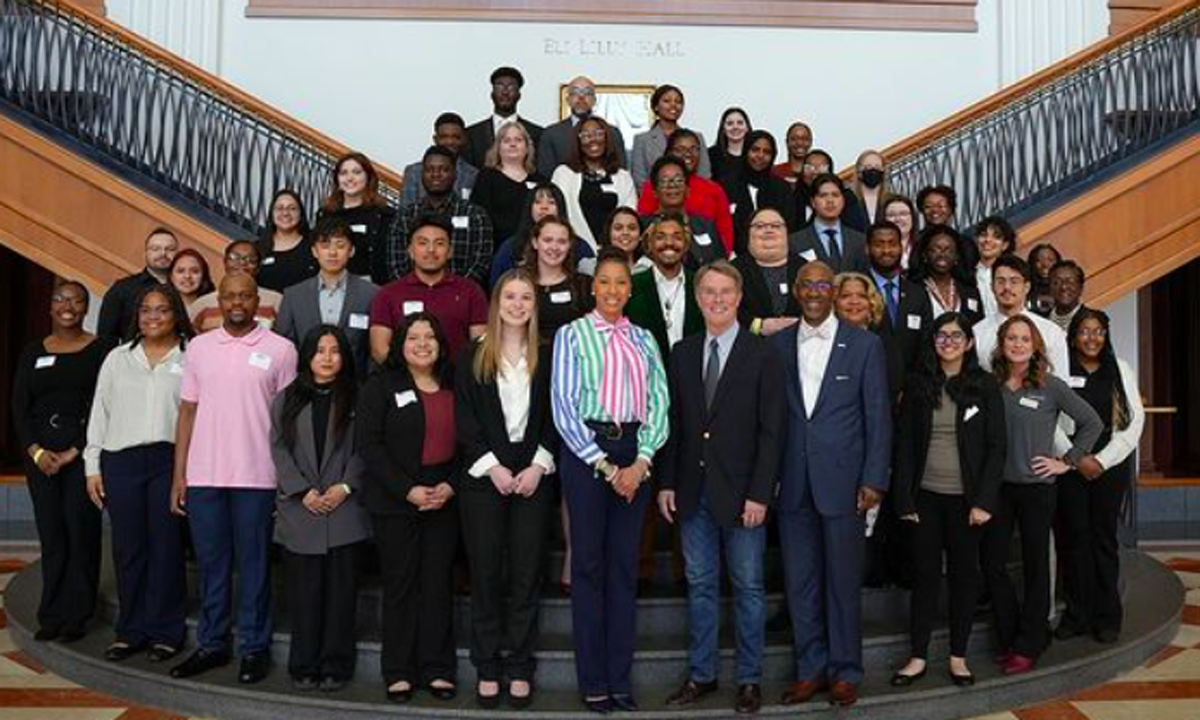The Future of High School: Engaging Students & Careers Through Modern Apprenticeships
EmployIndy CEO Marie Mackintosh: How schools can use apprenticeships and career experiences to re-engage young people for the 21st century.

Get stories like this delivered straight to your inbox. Sign up for The 74 Newsletter
This essay was originally published as part of the Center on Reinventing Public Education’s 2023 “State of the American Student” report. As part of the effort, CRPE asked 14 experts from various sectors to offer up examples of innovations, solutions or possible paths forward as education leaders navigate the current crisis. (See all the perspectives)
The United States has an education problem—low and declining test scores, disengaged students, and growing teacher shortages, among other challenges. In Indiana, fewer high school students are pursuing postsecondary education or completing a credential or degree. This decline in postsecondary enrollment and educational attainment is sharpest for Black and Hispanic/Latino students, especially males.
We also have a skills gap problem—not enough people with the skills to handle the jobs of the future—and the pandemic has accelerated this misalignment in supply and demand. In Indianapolis alone, at last count, we needed 215,000 people with job-ready credentials to close our skills gap.
Traditional approaches aren’t working. Communities like ours must become much more innovative if we wish to ensure a future of inclusive economic prosperity.
A continuum of career-connected learning
EmployIndy, a quasi-governmental intermediary organization, is doing what we can. We work closely with businesses, K-12, postsecondary and higher education, city and state agencies, and philanthropic organizations to ensure all local residents earn a livable wage and that local employers have the skilled talent they need to grow. In order to make our vision a reality, we invest in what works: good jobs, talent connections, coaching and training, and career-connected learning.
We leverage a continuum of career-connected learning to ensure Indy’s youth and young adults are positioned to meet the future needs of the local economy. This continuum includes a broad array of exploration, engagement, and experience opportunities. As part of this learning continuum, one of our most ambitious initiatives is a reinvented approach to apprenticeship, a job training model that dates back to the Middle Ages. Through the Modern Apprenticeship Program, which we operate with a sister intermediary, Ascend Indiana, we’re preparing high school students for the jobs of the future. By blurring the lines between education and work, we’re making learning more relevant for students. We’re giving businesses a fresh approach to a time-tested model. And we’re creating more pathways to prosperity for all students, with a particular focus on the underserved, underrepresented, and underprivileged in our community. By blurring the lines between education and work, we’re making learning more relevant for students. We’re giving businesses a fresh approach to a timetested model. And we’re creating more pathways to prosperity for all students.
More than 40 participating local employers and 14 high schools have come together to co-develop talent, offering apprenticeships across seven industries with the highest student interest:
• Healthcare services
• Information technology
• Business operations
• Advanced manufacturing
• Construction
• Education
• Financial services
Specific jobs range from project coordinators and staff accountants to maintenance technicians and IT support.
High school students earn while they learn. As juniors, they spend two days a week on the job, which increases to three days as seniors. One year after graduation, young adults have earned a high school diploma, college credits, and industry credentials. They have built a professional network. And they have a choice for their next step—college, postsecondary training, or work. What parent wouldn’t want that for their 18-year-old?
We’re having an impact. We’re helping diversify our workforce: about 88% of current apprentices are students of color, 60% are female, and one-third come from low-income households, doing jobs such as IT and accounting that historically have been dominated by white men. We’re reducing employer turnover: 94% of Indiana employees say they would stay with their companies longer if they invested in learning. And we’re having a positive return on investment: every $1 invested in apprenticeship returns $1.47.
Scaling what works
Our primary challenge now is to expand what’s working. We’ve incubated success. Now we must scale it. Doing so will require all parties to adjust how they do business in the 21st century.
Employers need to play a much bigger, more well-defined role in this new system. They must cocreate learning opportunities, advise on occupations and curriculum, become training companies for apprentices, and invest more time and treasure to ensure education and government partners are providing the most comprehensive education possible to young people. They need to engage their future workforce early, starting in middle school, and not wait until unprepared graduates fill out a job application.
High schools must continue to become more flexible, offering students more choices and pathways. They must work with their community partners to ensure all students are receiving the career-coaching support needed to make important decisions about their future. Graduation day must be seen as the starting line, not the endpoint.
Colleges and universities must become more adaptable, awarding credits for prior learning (including on the job) and working more closely with local employers on teaching applied skills. Clearly, there is a continued role for elite postsecondary programs, but we are equally committed to working with innovative community-focused institutions.
Government agencies must continue to broaden their measures of accountability to track not just high school graduation rates, college-going rates, or completion data, but more longitudinal and actionable data that allow institutions to make informed and equitable decisions about the needs of their constituents.
Young people themselves must step up and benefit from the growing opportunities to take charge of their own learning. Of course, they need to learn math, science, and reading. But just as important, they need a career plan. And they need to master durable skills such as problem solving, teamwork, and conflict resolution that will help them in school–and in life.
Apprenticeships are just one of the gateways we’re providing to young people to build skills and become future-ready. Working with multiple partners, we also support dropout prevention and recovery programs, administer career coaching and job training programs, and deliver a curriculum for young adults to learn durable skills in mindsets, self management, learning strategies, social skills, workplace skills, and launching a career.
Thanks to the leadership of Indianapolis Mayor Joe Hogsett, we’re also able to award college scholarships, provide completion grants, and connect teens to summer jobs, among other efforts. The City of Indianapolis has dedicated millions of dollars annually over the last five years to Indy Achieves, which works to ensure that every Indianapolis resident can pursue and complete a postsecondary credential or degree program. We empower residents to pursue careers that put them on a pathway to the middle class by removing barriers and providing a debt-free pathway to a better future. Mayor Hogsett also launched Project Indy as a critical first step in helping young people explore job opportunities and gain valuable experience and skills toward a future career. We’ve connected thousands of in-school and out-of-school youth in Marion County to summer jobs and work-based learning experiences.
One of our most innovative programs, YES Indy, invites out-of-school youth to play basketball at reengagement centers (RECs) as a first step in building the trust needed for them to reengage with school and work. The Indianapolis area has more than 30,000 such young people. It costs us about $12,500 each to reengage with them—a smart investment, considering it costs society three times more if they continue to stay out of school or work. As an intermediary working with many stakeholders, we’re a catalyst, a translator, and a funding go between. We’ve made hopeful progress since our founding in 1983. Our real success, however, will be when we’re not needed anymore, when businesses and institutions are working together as a matter of course, and routinely engaging students with real-world, hands-on, and creative assignments that help them become the lifelong learners every community needs.
See more from the Center on Reinventing Public Education and its 2023 “State of the American Student” report.
Get stories like these delivered straight to your inbox. Sign up for The 74 Newsletter

;)
